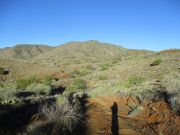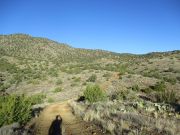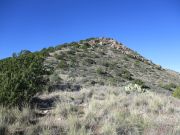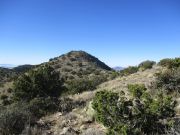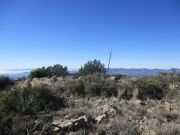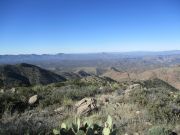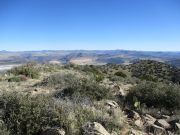
The Mountains of Arizona
• www.surgent.net
|
| Grayback Benchmark |
• Highpoint: Grayback Mountains • Arizona State Trust Lands • Yavapai County |
|
Date: February 8, 2020
• Elevation: 5,133 feet
• Prominence: 1,333 feet
• Distance: 8 miles
• Time: 4 hours, 40 minutes
• Gain: 1,310 feet (net), 1,790 feet (gross)
• Conditions: Sunny and clear, cold at first, warming later
Arizona
•
Main
•
AZ P1K
•
PB
•
LoJ
•
USGS BM Datasheet
Grayback Benchmark is the highest point of the Grayback Mountains, west of the mining town of Bagdad in southwestern Yavapai County. Matthias and Mike were here a few months ago and spoke positively of the hike. I put it on my short list, but waited until the weather was starting to warm (barely) in the deserts, which means conditions here would be just right.
The peak lies across the US-93 highway from last week's hike, Greenwood Peak. Being there last week got me thinking about coming back again for Grayback. The whole region is beautiful, a mix of mountains, canyons and high-desert valleys, and almost no hikers. Very few people come out this way for leisure, so solitude is nearly guaranteed.
I left home at 5:30 a.m. and followed the usual route, Loop-101, Interstate-17, AZ-74, then US-60 to Wickenburg, then US-93 out of town. I had a setting full moon as I drove in the pre-dawn darkness, the sun rising when I was well past Wickenburg. At this early hour, traffic on US-93 was light, but there were two active police-paramedic scenes: one was at a badly-damaged car, so I hope the occupants were okay, the other was a big-rig that tipped over when it evidently hit a soft shoulder.
I exited the US-93 onto AZ-97, the highway that connects to AZ-96, which goes to Bagdad. This is a scenic drive, with almost no traffic. I've been on this highway just a handful of times over the years. This would be my second time in Bagdad. The sun was up by now, low enough to be blinding when facing east. Fortunately, I mostly drove west, and had the sun behind me as I rolled into Bagdad, home to a huge pit mine, one of the biggest copper mines in the country.
I did not quite enter Bagdad. Instead, I turned left onto Yavapai Road, a small residential street near a baseball field. I went right, then right again near a home, following a paved road uphill and skirting over a whole row of homes. This is Old Dick Road, but no signs mentioned this. The pavement ends soon, and was decent hardpack thereafter. I followed the road for about 4 miles, parking in a small pullout called Mountain Spring, west of Waters Peak and east of Dick Peak. As is my habit, I could have driven farther but liked the parking spot for its size and convenience, and I was well within my "comfort radius" for hiking mileage. I was at 3,820 feet, intrapolating the elevation from the topogrphical map.
I got dressed properly and my gear together, and started hiking at 7:55 a.m.. The sky was clear with no clouds, but it as cold, 34 degrees F said my car's thermometer. I was in shade too. I walked up the continuation of Old Dick Road, covering about a mile as the road skirted north, then west, of Dick Peak. Along the way I encountered two guys in camo having a little trouble with their ATV on a slope (I offered to help, but they said they were good to go). This segment covered a little under a mile, and the "good" road ended at a five-way junction, elevation 4,060 feet. A right went uphill, a left went to a gate and up to Dick Peak, a harder left went up to a power pole, and a straight went downhill.
I came prepared with satellite images of the area, because I knew the area would be covered in roads. The topographical map shows some but not all roads, and I did not want to be spending all morning randomly trying roads. Although counter-intuitive, the proper route is to go straight and follow the lesser road downhill about three-quarters of a mile, dropping about 240 feet, putting me back to 3,820 feet. It was here that I had my first views of the main mountain ridges, although the summit was hidden from view by a foreground ridge for the time being. In fact, the summit would never be in view until I was within a half-mile of it.
I hiked downhill until I came to the first significant junction, and went right (west). This road then dropped into a drainage, then up and to a Y-split. I went right, gained onto a small ridge, dropped into another drainage, then up again to yet another ridge, to another junction of roads. I went straight, the road dropping again into another drainage (this one with an actual creek in it). The road then gains up a slope, and from this point forward, heads northwest, aiming for a saddle at about 4,300 feet elevation.
I walked the road, steep at times but usually at a moderate grade. The road has sections of chunky rock and would be a little narrow and rough for most vehicles, but ATVs could handle it (and there were recent tracks in the roadbed). I hiked until I was at the pass, which is fenced with a gate. Beyond the pass, there are views into the huge pits of the copper mine.
I turned left and started up the rocky and brushy slopes, shimmying under a fence along the way. I gained the low ridge and kept to it, aiming uphill. Up ahead were two rock knobs, a low one with moderate brush, and a higher one with more dramatic rock outcrops. The terrain was mostly open to where I could weave through the brush and cactus (almost no cholla, thank heavens). I followed open lanes and angled right onto what appeared to be an old track of some sort. This track went right and would bypass the first rock knob.
The track worked well as it offered a way through the brush, and it appeared to be more than a game trail. In places it really did appear to have been graded out at one time, and I saw what I think were old tailing mounds so there may have been a very modest prospect up here at one time. If there was a track, it is almost all returning to nature, and probably last saw a vehicle before I was born. Anyway, I was past the first rock knob. I angled upward onto the high ridge, and aimed uphill, climbing up and past the second rock knob, staying left which offered fewer rocks and slopes with good traction.
By now, I was above 5,000 feet elevation, and I could see the top, only 130 feet higher, and about a half-mile away. I walked went to another small hilltop, also elevation 5,000 feet, then angled south and walked up to the top. I arrived on the summit about two hours after starting, roughly a four-mile hike. The day was beautiful, now warming into the mid-50s. I found the benchmark, noted that the surveyor's post was still standing with the four guy wires still in good shape after all these years. I signed into the logbook, the first since Matthias and Mike, observing that not many people come up here: mostly the usual crowd (McLoed, Lilley, Moore, Jurasevich, Adrian, Nicholls, Packard, Martin, Klein, et al), the occasional hunter (because they said so) and a few mysterions. There were years when no one signed in.
I spent about 20 minutes up here, enjoying the quiet, the weather and the views. I could see Greenwood Peak from last week, plus the full scope of the pits of the mine. Beyond that were distant peaks, some on the Baca Land Grant (O RO Ranch) such as Mohon and Hope(less), our new clever name for that peak since we're unlikely ever to gain access to it. I could also see Juniper Mountain, the Hualapais, and looking east, peaks near Prescott, Crosby Peak and other summits whose names I don't know.
It was soon time to depart. I followed the same general route downhill, but when I got to a point above the lower rock knob, I gambled a little and descended a slope that looked pretty good, at first. I was able to scoot down about 250 feet onto a flat clearing, but the slopes below it were way too steep for my comfort. I sidehilled upward and back to the rocks, eventually getting myself back to the slopes that led to that old track mentioned earlier. My gamble did not pay off and it cost me about 20 minutes.
Back on track, I made good time heading downward. When I could see the road again, I bailed off the ridge and beelined to it, meeting the road about a quarter-mile below the gate. From here on out, I just followed the road back to my car. I did not see anyone, but I could hear shooting going on. I'm pretty sure most locals here prefer shooting to hiking. I was back to my car at 12:40 p.m., the descent hike taking about as long as my ascent hike. I changed and then drove out to pavement.
I drove into downtown Bagdad, which consists of a grocery, a diner, a gas station and a minimart. I got snacks at the minimart. A bunch of motorcyclists were encamped at the diner. This is a pretty area: the town is surrounded by low hills, low enough to be desert but high enough to have more trees and brush than the lower deserts. Bagdad is a company town, and pretty much isolated from the rest of the state. State Route AZ-96 is the only way in, not counting scraggly ranch roads and desert tracks. It's not close to any other town. Should the mine close down, Bagdad would go with it. However, the town has been here for over a hundred years, so it'll probably stick around for awhile. It could morph into some artsyville like Bisbee, or a retirement community or a tourist town geared for backwoods exploration or hunting. I like it here and enjoy the drive into and out of it.
On the drive out, I inspected roads to other peaks in the area, adding about an hour to my day. Otherwise, I just drove US-93 back into Wickenburg, then the other highways back home. By now, traffic was heavier, but I was able to avoid bad traffic, and arrived home about 4 p.m..
I enjoyed this peak. The hiking was easy (with satellite images to help with the roads), the terrain was not too annoying and there wasn't any of that horrible grus gravel like on last week's hike. The dirt road wasn't too bad, either. It was pretty good for about two miles, then after a junction with Kellis Ranch Road, decreased in quality slightly. It had some ruts and slightly-rocky segments, but nothing challenging. Most vehicles with decent clearance should be able to get as far as I did. If the roads are wet, then all bets are off.
|
|
